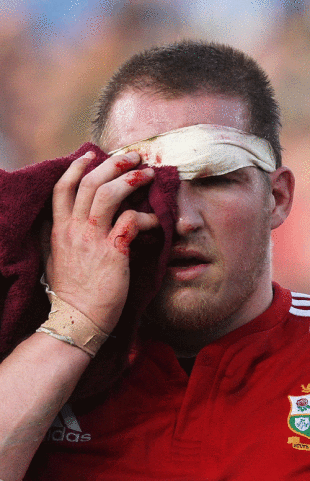|
International Rugby
RFU survey points to injury increase
Scrum.com
January 20, 2010

Gethin Jenkins was one of a number of casualties for the Lions in South Africa
© Getty Images
Enlarge
A leading study into the frequency of injuries occurring at elite level in England has found that they are on the rise for the first time since 2003. The England Rugby Injury and Training Audit 2008-09, conducted by the Rugby Football Union, the Rugby Players' Association and Premier Rugby, pinpoints knee ligament and hamstring injuries as the main areas of concern following a sixth year of investigation. The audit comes following a season of high-profile injuries and fears that the game had become too physical. British & Irish Lions doctor James Robson led the call for change after describing the aftermath of the tourists' brutal second Test defeat, a game which resulted in a dislocated shoulder for prop Adam Jones, a fractured cheekbone for Gethin Jenkins and tour-ending injuries for Brian O'Driscoll and Jamie Roberts, as "distressing". Overall the survey recorded 769 match injuries from the Guinness Premiership, Anglo-Welsh Cup and European competitions and 258 training injuries, with an injury being defined as a problem causing a player to miss training for more than 24 hours. Game injuries increased by 119 from the previous season, although training injuries were down from 318 to 258. "What we saw last season was an increase in both the likelihood of a match injury and the length of time an injury keeps a player out," Dr Simon Kemp, RFU Head of Sports Medicine, said. "It's difficult to be sure as to the precise reasons for this increase but a small increase in two uncommon injuries (anterior cruciate ligament ruptures and foot fractures) both of which typically keep a player out for more than 84 days were responsible for 50% of this increase. "We now need to integrate the injury audit with a video analysis of the structure of the elite game and of game injury events. This will give us a better understanding of the relationship between changes in the frequency and nature of game events (tackles, rucks, mauls, scrums, lineouts, restarts) i.e. the overall shape of the game and injury risk. "We have based our recommendations on an accepted injury risk management process. This involves not only improving the quality of the data we collect but also looking to develop how we evaluate and then mitigate risk by involving a multi-disciplinary group, rather than just medics, in the processes. Players, coaches, conditioners, referees, law makers, the disciplinary process all have key roles to play." Damian Hopley, Chief Executive of the Rugby Players' Association, commented, "The increased number of injuries reported in this invaluable audit are of significant concern to the RPA and our members, and the findings reinforce the requirement for further research into acceptable levels of workload and demands made of rugby players by the modern elite game. "This commitment to further research, seeking to investigate the underlying causes of the rise in injuries, will be crucial in ensuring we continue to optimally manage our players' health, protection and welfare effectively." © Scrum.com
|
Live Sports
Communication error please reload the page.
-
Football
-
Cricket
-
Rugby
-
- Days
- Hrs
- Mins
- Secs
F1 - Abu Dhabi GP
Abu Dhabi Grand Prix December 11-131. Max Verstappen ()
2. Valtteri Bottas (Mercedes)
3. Lewis Hamilton (Mercedes)
4. Alexander Albon ()
5. Lando Norris ()
6. Carlos Sainz Jr ()
-
ESPNOtherLive >>
Snooker - China Open
Tennis - Miami Open

